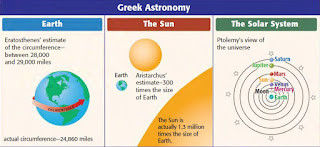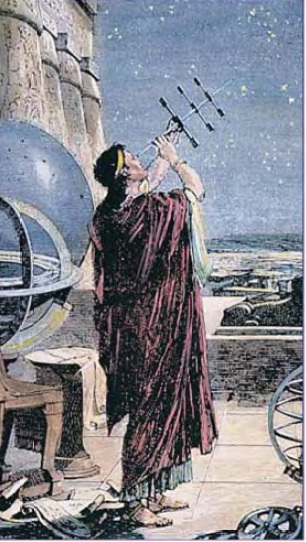The Spread of Hellenistic Culture
Hellenistic
Culture in Alexandria
As a result of
Alexander’s policies, a vibrant new culture emerged. Greek (also known as
Hellenic) culture blended with Egyptian, Persian, and Indian influences. This
blending became known as Hellenistic culture. Koine, the popular
spoken language used in Hellenistic cities, was the direct result of cultural
blending. The word koine came from the Greek word for “common.” The language
was a dialect of Greek. This language enabled educated people and traders
from diverse backgrounds to communicate in cities throughout the Hellenistic
world.
|
การแพร่ขยายของวัฒนธรรมเฮลเลนิสต์
วัฒนธรรมเฮลเนิกในอเล็กซานเดรีย
เนื่องจากนโยบายของพระเจ้าอเล็กซานเดอร์
วัฒนธรรมใหม่อันเจิดจ้าก็ปรากฏขึ้น ชาวกรีก (เรียกอีกอย่างหนึ่งว่า เฮลเลนิก)
ผสมผสานกับอิทธิพลของอียิปต์ เปอร์เซียและอินเดีย การผสมผสานนี้ เรียกว่า
วัฒนธรรมเฮลเลนิสต์ ภาษาคอยนี คือภาษาที่พูดกันทั่วไปใช้ในเมืองของชาวเฮลเลนิสต์
เป็นผลโดยตรงจากการผสมผสานทางวัฒนธรรม คำว่า Koine มาจากภาษากรีก
แปลว่า “ธรรมดาสามัญ” ภาษาคอยนีเป็นภาษาถิ่นของชาวกรีก
ภาษานี้สามารถใช้ได้กับคนผู้มีการศึกษาและพ่อค้าที่มาจากหลากหลายภูมิหลังเพื่อสื่อสารในเมืองต่าง
ๆ ทั่วโลกชาวเฮลเลนิสต์
|
|
Trade and Cultural
Diversity
Among the many cities
of the Hellenistic world, the Egyptian city of Alexandria became the
foremost center of commerce and Hellenistic civilization. Alexandria
occupied a strategic site on the western edge of the Nile delta.
Trade ships from all around the Mediterranean docked in its spacious
harbor. Alexandria’s thriving
commerce enabled it to grow and prosper. By the third
century B.C., Alexandria had become
an international community, with a rich mixture of customs and traditions
from Egypt and from the Aegean. Its diverse population
exceeded half a million people.
|
การค้าขายและความหลากหลายทางวัฒนธรรม
ท่ามกลางเมืองหลายแห่งในโลกชาวเฮลเลนิสต์
เมืองอะเล็กซานเดรียของอียิปต์กลายเป็นศูนย์กลางการค้าขายและอารยธรรมเฮลเลนิสต์เก่าแก่ที่สุด
เมืองอะเล็กซานเดรียยึดครองพื้นที่เชิงกลยุทธ์บนขอบตะวันตกของสามเหลี่ยมปากแม่น้ำไนล์
เรือค้าขายขนาดใหญ่จากทั่วทุกแห่งในทะเลเมดิเตอร์เรเนียนจะจอดเทียบท่าเรืออันกว้างใหญ่
การค้าขายที่เจริญรุ่งเรืองของเมืองอะเล็กซานเดรียทำให้เมืองเจริญเติบโตและรุ่งเรือง
เมื่อถึงศตวรรษที่ 3 ก่อนคริสตกาล เมืองอะเล็กซานเดรียได้กลายเป็นประชาคมระหว่างประเทศ
ที่มีการผสมผสานขนบธรรมเนียมและประเพณีอันมีคุณค่าจากประเทศอียิปต์และจากทะเลอีเจียน
ประชากรที่หลากหลายของอะเล็กซานเดรียเกินกว่าครึ่งล้านคน
|
|
Alexandria’s Attractions
Both residents and
visitors admired Alexandria’s great beauty.
Broad avenues lined with statues of Greek gods divided the city into blocks. Rulers built magnificent royal palaces overlooking the
harbor. A much-visited tomb contained Alexander’s elaborate glass coffin. Soaring more
than 350 feet over the harbor stood an enormous stone lighthouse called the
Pharos. This lighthouse contained a polished bronze
mirror that, at night, reflected the light from a
blazing fire. Alexandria’s greatest
attractions were its famous museum and library. The
museum was a temple dedicated to the Muses, the Greek goddesses of arts and
sciences. It contained art galleries, a zoo, botanical
gardens, and even a dining hall. The museum was an
institute of advanced study.
The Alexandrian
Library stood nearby. Its collection of half a million papyrus scrolls
included many of the masterpieces of ancient literature. As the first true research
library in the world, it helped promote the work of a gifted group of
scholars. These scholars greatly respected the earlier works of classical
literature and learning. They produced commentaries that explained these
works.
|
สถานที่ท่องเที่ยวของเมืองอะเล็กซานเดรีย
ทั้งผู้พักอาศัยและผู้มาเยือนชื่นชมความงดงามอันยิ่งใหญ่ของเมืองอะเล็กซานเดรีย
ถนนหนทางกว้างขวางซึ่งเรียงรายไปด้วยรูปปั้นเทพเจ้ากรีกแบ่งเมืองออกเป็นส่วน ๆ ผู้ปกครองได้สร้างพระราชวังอันงดงามที่สามารถมองเห็นท่าเรือได้
สุสานที่มีผู้เข้าเยี่ยมชมมากมีโลงแก้วที่ละเอียดอ่อนของอเล็กซานเดอร์ ประภาคารหินขนาดใหญ่
ชื่อ ฟาโรส (Pharos) ตั้งตระหง่านสูงมากกว่า 350 ฟุตเหนือท่าเรือ ประภาคารนี้มีกระจกสีบรอนซ์ขัดเงา ซึ่งในเวลากลางคืนจะสะท้อนแสงจากเปลวเพลิง
สถานที่ท่องเที่ยวที่ยิ่งใหญ่ที่สุดของเมืองอะเล็กซานเดรีย ได้แก่
พิพิธภัณฑ์และห้องสมุดที่มีชื่อเสียง พิพิธภัณฑ์เป็นวิหารที่สร้างอุทิศให้กับเทพมิวส์
(Muses) เทพธิดาแห่งศิลปะและวิทยาศาสตร์ของกรีก มีหอศิลป์ สวนสัตว์
สวนพฤกษศาสตร์และแม้แต่ห้องอาหาร พิพิธภัณฑ์ คือ สถาบันการศึกษาชั้นสูง
ห้องสมุดแห่งเมืองอะเล็กซานเดรียตั้งอยู่ใกล้
ๆ เป็นที่เก็บม้วนกระดาษพาไพรัสครึ่งล้านม้วนประกอบด้วยผลงานชิ้นเอกของวรรณคดีโบราณมากมาย
เนื่องจากเป็นห้องสมุดแห่งการวิจัยอย่างแท้จริงครั้งแรกในโลก จึงช่วยส่งเสริมผลงานของกลุ่มนักวิชาการผู้มีพรสวรรค์
นักวิชาการเหล่านี้ส่วนใหญ่มีความสนใจผลงานยุคก่อนของวรรณกรรมและการเล่าเรียนที่มีชื่อเสียงโด่งดัง
ท่านเหล่านั้นได้สร้างอรรถาธิบายที่อธิบายผลงานเหล่านี้
|
|
Hipparchus, who lived
in Alexandria for a time, charted the position of 850 stars.
ฮิปปาร์คัส
(หรือฮิปปาร์คอส) ซึ่งอาศัยอยู่ในเมืองอะเล็กซานเดรียอยู่พักหนึ่ง ได้ทำแผนที่ตำแหน่งดวงดาวไว้ถึง
850 ดวง
Science and
Technology
Hellenistic
scholars, particularly those in Alexandria, preserved Greek and Egyptian
learning in the sciences. Until the scientific advances of the 16th and 17th
centuries, Alexandrian scholars provided most of the scientific knowledge available
to the West.
|
วิทยาศาสตร์และเทคโนโลยี
นักวิชาการชาวเฮลนิสต์
โดยเฉพาะที่อยู่ในเมืองอะเล็กซานเดรีย ได้อนุรักษ์การเล่าเรียนวิทยาศาสตร์ของกรีกและอียิปต์
ก่อนจะมีความก้าวหน้าด้านวิทยาศาสตร์ในยุคศตวรรษที่ 16 และ 17
นักวิชาการแห่งอะเล็กซานเดรียได้มอบความรู้ด้านวิทยาศาสตร์ส่วนใหญ่ที่ให้ประโยชน์แก่ตะวันตก
|
|
Astronomy
Alexandria’s museum
contained a small observatory in which astronomers could study the planets
and stars. One astronomer, Aristarchus of Samos, reached two significant
scientific conclusions. In one, he estimated that the Sun was at least 300
times larger than Earth. Although he greatly underestimated the Sun’s true
size, Aristarchus disproved the widely held belief that the Sun was smaller
than Greece. In another conclusion, he proposed that Earth and the other
planets revolve around the Sun. Unfortunately for science, other astronomers refused
to support Aristarchus’ theory. In the second century A.D., Alexandria’s last
renowned astronomer, Ptolemy, incorrectly placed Earth at the center of the
solar system. Astronomers accepted this view for the next 14 centuries.
Eratosthenes, the
director of the Alexandrian Library, tried to calculate Earth’s
true size. Using geometry, he computed Earth’s circumference at between 28,000 and 29,000 miles. Modern measurements put the circumference at 24,860 miles. As well as a highly regarded astronomer and mathematician, Eratosthenes
also was a poet and historian.
|
ดาราศาสตร์
พิพิธภัณฑ์แห่งอะเล็กซานเดรียมีหอสังเกตการณ์ขนาดเล็ก
ซึ่งนักดาราศาสตร์สามารถไปศึกษาดาวเคราะห์และดาวฤกษ์ได้ นักดาราศาสตร์คนหนึ่ง
นามว่า อริสตาร์คัสแห่งเมืองซามอสได้ประสบผลสำเร็จในการสรุปวิทยาศาสตร์สำคัญ 2 ประการ
คือ ประการแรก เขาได้คำนวณว่า ดวงอาทิตย์ใหญ่กว่าโลกอย่างน้อยที่สุด 300 เท่า แม้จะคำนวณขนาดของดวงอาทิตย์ต่ำกว่าความเป็นจริงมาก
อริสตาร์คัสยังได้พิสูจน์ความเชื่อที่ยึดถือกันอย่างกว้างขวางว่าดวงอาทิตย์เล็กกว่าประเทศกรีซเป็นสิ่งที่ผิด
ประการที่สอง เขาได้เสนอข้อคิดว่า โลกและดาวเคราะห์ดวงอื่น โคจรรอบดวงอาทิตย์ โชคไม่ดีสำหรับวิทยาศาสตร์
ที่นักดาราศาสตร์คนอื่น ๆ ปฏิเสธที่จะสนับสนุนทฤษฎีของอริสตาร์คัส
ในคริสต์ศตวรรษที่ 2 ทอเลมี นักดาราศาสตร์ผู้มีชื่อเสียงคนล่าสุดของอะเล็กซานเดรียวางโลกเป็นจุดศูนย์กลางของระบบสุริยะอย่างไม่ถูกต้อง
เหล่านักดาราศาสตร์ยอมรับทัศนะนี้ต่อมาถึง 14 ศตวรรษ
เอราทอสเทนีส ผู้อำนวยการห้องสมุดแห่งเมืองอะเล็กซานเดรีย
พยายามคำนวณขนาดที่แท้จริงของโลก โดยใช้รูปทรงเรขาคณิต เขาคำนวณเส้นรอบวงของโลกได้ระหว่าง
28,000 ถึง 29,000 ไมล์ การวัดในสมัยปัจจุบันวัดเส้นรอบวงอยู่ได้
24,860 ไมล์ นอกจากเอราทอสเทนีสจะเป็นนักดาราศาสตร์และนักคณิตศาสตร์ที่ได้รับการยกย่องเป็นอย่างมากแล้ว
ยังเป็นนักกวีและนักประวัติศาสตร์อีกด้วย
|
|
Mathematics and
Physics
In their work,
Eratosthenes and Aristarchus used a geometry text compiled by Euclid. Euclid
was a highly regarded mathematician who taught in Alexandria. His best-known
book, Elements, contained 465 carefully presented geometry
propositions and proofs. Euclid’s work is still the basis for courses in
geometry.
Another
important Hellenistic scientist, Archimedes of Syracuse,
studied at Alexandria. He accurately estimated the value of pi (π)—the ratio
of the circumference of a circle to its diameter. In addition, Archimedes explained
the law of the lever.
Gifted in both geometry and
physics, Archimedes also put his genius to practical use. He invented the
Archimedes screw, a device that raised water from the ground, and the
compound pulley to lift heavy objects. Using Archimedes’
ideas, Hellenistic scientists later built a force pump, pneumatic machines,
and even a steam engine.
|
คณิตศาสตร์และฟิสิกส์
ในผลงานของเอราทอสเทนีสและอริสตาร์คัส
ท่านทั้งสองนั้นได้ใช้ตำราเรขาคณิตที่รวบรวมขึ้นโดยยูคลิด ยูคลิดเป็นนักคณิตศาสตร์ที่น่าเคารพยกย่องเป็นอย่างมาก
ที่ทำการสอนในเมืองอะเล็กซานเดรีย คัมภีร์ที่มีชื่อเสียงที่สุด คือ Elements บรรจุข้อเสนอและข้อพิสูจน์เกี่ยวกับเรขาคณิตที่นำเสนอไว้อย่างละเอียดถี่ถ้วน
จำนวน 465 ข้อ ผลงานของยูคลิดยังคงเป็นพื้นฐานให้กับหลักสูตรในวิชาเรขาคณิต
นักวิทยาศาสตร์ที่สำคัญอีกคนหนึ่ง
คือ อาคิมิดีส แห่งเมืองไซราคิวส์ (ไซราคูซา) ได้รับการศึกษาที่เมืองอะเล็กซานเดรีย
เขาได้คำนวณค่าของไพ (ᴫ) ซึ่งเป็นอัตราส่วนเส้นรอบวงของวงกลมกับจุดศูนย์กลาง นอกจากนี้
อาคิมิดีสยังได้อธิบายกฎของคานดีดไว้ด้วย
อาคิมิดีสซึ่งได้รับรางวัลด้านเรขาคณิตและฟิสิกส์
ยังได้ใส่ความอัจฉริยภาพของตนเองไว้ให้กับการใช้ในภาคปฏิบัติด้วย ด้วยการประดิษฐ์สลักเกลียวอาคิมิดีส
ซึ่งเป็นอุปกรณ์สำหรับยกน้ำจากพื้นดินและลูกรอกจากส่วนผสมสำหรับยกวัตถุที่หนัก ๆ
ไว้ด้วย ต่อมานักวิทยาศาสตร์ชาวเฮลเลนิสต์ได้ใช้แนวความคิดของอาคิมิดีส
ได้สร้างเครื่องสูบน้ำอันทรงพลัง เครื่องจักรที่ใช้กำลังอัดของอากาศ และแม้กระทั่งเครื่องจักรไอน้ำ
|
|
Philosophy and Art
The teachings of
Plato and Aristotle continued to be very influential in Hellenistic
philosophy. In the third century B.C., however, philosophers became concerned
with how people should live their lives. Two major philosophies developed out
of this concern.
|
วิชาปรัชญาและวิชาศิลปะ
คำสอนของเพลโตและอาริสโตเติล ยังมีอิทธิพลต่อปรัชญาของเฮลเลนิสต์ต่อมา แต่อย่างไรก็ตาม ในศตวรรษที่ 3 ก่อนคริสตกาล เหล่านักปรัชญามีความห่วงใยว่าผู้คนควรจะดำเนินชีวิตด้วยวิถีทางใด
จึงได้พัฒนาปรัชญาที่สำคัญ 2 ประการจากความห่วงใยนี้
|
|
Stoicism and
Epicureanism
A Greek philosopher
named Zeno (335–263 B.C.) founded the school of philosophy called Stoicism.
Stoics proposed that people should live virtuous lives in harmony with the
will of god or the natural laws that God established to run the universe.
They also preached that human desires, power, and wealth
were dangerous distractions that should be checked. Stoicism promoted social
unity and encouraged its followers to focus on what they could control.
Epicurus founded the
school of thought called Epicureanism. He taught that gods who had no
interest in humans ruled the universe. Epicurus believed that the only real
objects were those that the five senses perceived. He taught that the
greatest good and the highest pleasure came from virtuous conduct and the
absence of pain. Epicureans proposed that the main goal of humans was to
achieve harmony of body and mind. Today, the word epicurean means a
person devoted to pursuing human pleasures, especially the enjoyment of good
food. However, during his lifetime, Epicurus advocated moderation in all
things.
|
|
ลัทธิสโตอิกและสุขนิยมของเอพิคิวรัส
นักปรัชญาชาวกรีกนามว่า ซีโน (มีอายุระหว่าง 335 – 263 ปีก่อนคริสตกาล ประมาณ พ.ศ. 54 – 113
อายุ 59 ปี?) ลัทธิสโตอิกเสนอแนะว่าควรจะดำเนินชีวิตด้วยคุณธรรมประสานไปกับเจตจำนงของพระเจ้าหรือกฎธรรมชาติที่พระเจ้าทรงสถาปนาไว้ให้ควบคุมบังคับบัญชาจักรวาล
ชาวสโตอิกยังได้สอนไว้ว่า ความปรารถนา อำนาจ และทรัพย์สมบัติของมนุษย์ภาวะรบกวนจิตใจที่เป็นอันตรายซึ่งควรจะได้รับการควบคุม
ลัทธิสโตอิกส่งเสริมความเป็นเอกภาพของสังคมและกระตุ้นให้สานุศิษย์มุ่งความสนใจไปที่สิ่งที่ตนเองสามารถควบคุมได้
เอพิคิวรัสได้ก่อตั้งสำนักความคิด
ชื่อว่า ลัทธิเอพิคิวเรียน ท่านสอนว่าพระเจ้าผู้ไม่เอาใจใส่ในมนุษย์จะปกครองจักรวาล
เอพิคิวรัส เชื่อว่า สิ่งที่แท้จริงมีเพียงอย่างเดียว คือ สิ่งที่ประสาทสัมผัสทั้งห้ารับรู้ได้
และสอนว่า ความดีที่ยิ่งใหญ่ที่สุดและความสุขสูงสุดมาจากการปฏิบัติที่ดีและการไม่มีความเจ็บป่วย
ลัทธิเอพิคิวเรียน เสนอว่า เป้าหมายหลักของมนุษย์คือเพื่อให้ร่างกายและจิตใจเกิดความสามัคคีกัน
ปัจจุบันนี้คำว่า "เอพิคิวเรียน"
หมายถึงบุคคลที่ทุ่มเทให้กับการแสวงหาความสุขของมนุษย์โดยเฉพาะอย่างยิ่งความเพลิดเพลินในการรับประทานอาหารที่เอร็ดอร่อย
อย่างไรก็ตาม ในช่วงชีวิตของท่าน เอพิคิวรัสสนับสนุนความพอเหมาะพอดีในทุกสิ่งทุกอย่าง
|
|
Realism
in Sculpture
Like
science, sculpture flourished during the Hellenistic age. Rulers, wealthy
merchants, and cities all purchased statues to honor gods, commemorate
heroes, and portray ordinary people in everyday situations. The largest known
Hellenistic statue was created on the island of Rhodes. Known as the Colossus
of Rhodes, this bronze statue stood more than 100 feet high. One of the seven
wonders of the ancient world, this huge sculpture was toppled by an
earthquake in about 225 B.C. Later, the bronze was sold for scrap. Another magnificent
Hellenistic sculpture found on Rhodes was the Nike (or Winged Victory) of Samothrace.
It was created around 203 B.C. to commemorate a Greek naval victory.
Hellenistic sculpture
moved away from the harmonic balance and idealized forms of the classical
age. Instead of the serene face and perfect body of an idealized man or
woman, Hellenistic sculptors created more natural works. They felt free to
explore new subjects, carving ordinary people such as an old, wrinkled peasant
woman.
By 150 B.C., the
Hellenistic world was in decline. A new city, Rome, was growing and gaining
strength. Through Rome, Greek-style drama, architecture, sculpture, and
philosophy were preserved and eventually became the core of Western
civilization.
|
|
สัจนิยมในประติมากรรม
ประติมากรรมเหมือนกับวิทยาศาสตร์มีความรุ่งเรืองในยุคเฮลเลนิสต์
นักปกครอง พ่อค้าผู้มั่งคั่ง และเมืองทุกเมืองได้ซื้อรูปปั้นมาเพื่อถวายความเคารพแก่เหล่าเทพเจ้า
อนุสรณ์วีรบุรุษ และวาดภาพเหมือนบุคคลทั่วไปในสถานการณ์ทุก ๆ วัน รูปปั้นชาวเฮลเลนิสต์ที่มีชื่อเสียงขนาดใหญ่ที่สุดสร้างขึ้นบนเกาะโรดส์
รูปปั้นทองสัมฤทธิ์นี้ เรียกว่า Colossus
of Rhodes (มหารูปแห่งโรดส์) ยืนตั้งตระหง่านสูงกว่า
100 ฟุต เป็นสิ่งมหัศจรรย์แห่งหนึ่งของโลกโบราณ ประติมากรรมขนาดมหึมานี้ล่มสลายลงเพราะแผ่นดินไหว
ประมาณ 225 ปีก่อนคริสตกาล ต่อมา ทองสัมฤทธิ์ก็ถูกขายไปเป็นชิ้นเล็กชิ้นน้อย
ประติมากรรมของชาวเฮลเลนิสต์ที่งดงามโอ่อ่าอีกอันหนึ่งที่ค้นพบบนเกาะโรดส์ คือ เทพีไนกี้
(หรือ Winged Victory = อนุสรณ์ชัยชนะ
เป็นภาพเทพีไนกี้หัวขาดกางปีก) แห่งซาโมเทรซ สร้างขึ้นประมาณ
203 ปีก่อนคริสตกาล เพื่อเป็นอนุสรณ์แก่ชัยชนะของนาวิกโยธินชาวกรีก
ประติมากรมของเฮลเลนิสต์ได้เปลี่ยนความสมดุลอย่างประสานกลมกลืนกันและเป็นแบบอย่างรูปแบบของยุคคลาสสิก
ประติมากรรมเฮลเลนิสต์เป็นตัวแทนของใบหน้าที่เรียบสงบและร่างกายที่สมบูรณ์แบบของบุรุษและสตรีในอุดมคติ
สร้างผลงานที่เป็นธรรมชาติมากขึ้น ประติมากรรมเหล่านั้นมีความรู้สึกให้อิสระในการสำรวจวัตถุใหม่
ๆ ที่แกะสลักบุคคลธรรมดาทั่วไป เช่น สตรีชาวไร่ชาวนา ในวัยชรา แสดงถึงความยากลำบาก
ประมาณ 150 ปีก่อนคริสตกาล
โลกของชาวเฮลเลนิสต์ก็ล่มสลายลง เมืองใหม่ คือ กรุงโรม
กำลังเจริญรุ่งเรืองและมีความเข้มแข็งขึ้น บทละคร สถาปัตยกรรม ประติกรรม
และปรัชญาได้รับอนุรักษามาทางกรุงโรมและในที่สุดก็ลายเป็นแกนหลักของอารยธรรมตะวันตก
|
|
|
||
|
Pythagorean
Theorem
Geometry students remember
Pythagoras for his theorem on the triangle, but its principles were known
earlier. This formula states that the square of a right
triangle’s hypotenuse equals the sum of the squared
lengths of the two remaining sides. Chinese
mathematicians knew this theory perhaps as early as 1100 B.C. Egyptian surveyors put it to practical use even earlier.
However, the work of
the school that Pythagoras founded caught the interest of later mathematicians. Shown are Euclid’s proof in Greek along
with a Chinese and an Arabic translation. The Arabs who
conquered much of Alexander’s empire spread Greek
mathematical learning to the West. The formula became known
as the Pythagorean theorem throughout the world.
|
|
ทฤษฎีบทพีทาโกรัส
นักเรียนเรขาคณิตจะจำพีทาโกรัสได้จากทฤษฎีบทของเขาในรูปสามเหลี่ยม
แต่หลักการของมันเป็นที่รู้จักกันก่อนหน้านี้ สูตรนี้ระบุว่า สี่เหลี่ยมจัตุรัสด้านตรงข้ามมุมฉากของสามเหลี่ยมด้านขวามือจะเท่ากับผลรวมของความยาวที่เป็นสี่เหลี่ยมของด้านสองด้านที่เหลืออยู่
นักคณิตศาสตร์ชาวจีนรู้ว่าทฤษฎีนี้อาจจะมีมาอย่างเร็วที่สุดเมือประมาณ 1,100 ปีก่อนคริสต์ศักราช
นักสำรวจชาวอียิปต์นำมาใช้ประโยชน์ได้ก่อนหน้านี้เสียด้วยซ้ำ
อย่างไรก็ตาม
ผลงานของโรงเรียนที่พีทาโกรัส ก่อตั้งขึ้นได้รับความสนใจจากนักคณิตศาสตร์ในยุคต่อมา
หลักฐานของยูคลิด แสดงเป็นภาษากรีกพร้อมกับคำแปลภาษาจีนและภาษาอาหรับ
ชาวอาหรับที่เอาชนะจักรวรรดิของอเล็กซานเดอร์เป็นจำนวนมากได้แพร่กระจายการเรียนรู้ทางคณิตศาสตร์ของกรีกไปยังตะวันตก
สูตรนี้กลายเป็นที่รู้จักกันไปทั่วโลกว่า ทฤษฎีบทพีทาโกรัส
|




